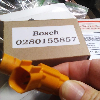Thanks, Mark -- that's great info to have.
I just installed a heater-control valve. (My '93 didn't have one.) A previous owner apparently had the condenser sealed, so I didn't have to do that.
The valve is not difficult to install. The challenge was getting a hard plastic vacuum line through the firewall. Here's how it went:
I cut the heater hoses where they run next to the evaporator. It's really the only place to do it without all kinds of parts-pulling.
Here's a close-up view of the valve, which I got from NAPA for just under $30.
You will need four clamps. My mistake was in cutting about an inch out of each line, thinking the valve would take up the slack. You'll actually need that extra inch because the hoses will be offset (upward-downward) by the valve. So don't cut any extra off.
Close-up on the vacuum-diaphragm part of the valve. See the hard, white, plastic line (sorry, out of focus)? That's the last part you'll connect when you're done.
Here's where I took the glove box off to access the MAX AC vacuum diaphragm. (Turns out I didn't need to remove the door, but it helps to show you what I'm talking about.) The black strip with the holes is where the glove box hinge was attached. The silver part is what moves when you switch to MAX AC. Its vacuum diaphragm is the round black part just below. At the bottom of that is the vacuum fitting you'll need to tap.
Here was the difficult part. The hard, white plastic line needed to go through the firewall right where you see it below. (You can also see it toward the bottom of the picture above.) Trouble is, it's a tight fit through a thick grommet and there's gooey sealant inside the grommet.
First I pushed an awl through and wiggled it to make a hole. Then I sliced the plastic line at an angle and slicked up the very end with silicone spray (not too much: your fingers will slip) and pushed it through, just firmly enough not to bend the line. On the third try, it came out on the firewall side just below the new valve. (The first two tries, I couldn't find where it was coming out!)
I got a black plastic tee at a hardware store and used some 1/8" ID clear hose to join it up to the new plastic line, and to the diaphragm under the dash. The amber fitting on the right is what originally plugged into the diaphragm. I thought it easier to use the clear hose to join the diaphragm to the tee, then hook it all up as shown.
A piece of clear hose works well to join the hard plastic line to the valve diaphragm under the hood.
I'll see how it goes. In Dallas, we need all the AC we can get!










